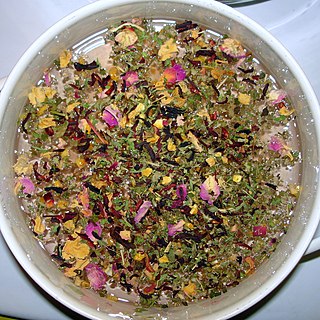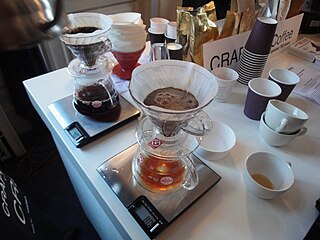
Ethiopian cuisine characteristically consists of vegetable and often very spicy meat dishes. This is usually in the form of wat, a thick stew, served on top of injera, a large sourdough flatbread, which is about 50 centimeters in diameter and made out of fermented teff flour. Ethiopians usually eat with their right hands, using pieces of injera to pick up bites of entrées and side dishes.

Herbal teas, also known as herbal infusions and less commonly called tisanes, are beverages made from the infusion or decoction of herbs, spices, or other plant material in hot water; they do not usually contain any true tea. Often herb tea, or the plain term tea, is used as a reference to all sorts of herbal teas. Many herbs used in teas/tisanes are also used in herbal medicine. Some herbal blends contain true tea.

Coffee is a beverage brewed from roasted coffee beans. Darkly colored, bitter, and slightly acidic, coffee has a stimulating effect on humans, primarily due to its caffeine content. It has the highest sales in the world market for hot drinks.
Post Consumer Brands is an American consumer packaged goods food manufacturer headquartered in Lakeville, Minnesota.

Postum is a powdered roasted grain beverage popular as a coffee substitute. The caffeine-free beverage was created by Post Cereal Company founder C. W. Post in 1895 and marketed as a healthier alternative to coffee. Post was a student of John Harvey Kellogg, who believed that caffeine was unhealthy. Post Cereal Company eventually became General Foods, then merged to Kraft Foods Inc. in 1990. Eliza's Quest Foods now owns the trademark rights and secret recipe of Postum.

In brewing, adjuncts are unmalted grains or grain products used in brewing beer which supplement the main mash ingredient. This is often done with the intention of cutting costs, but sometimes also to create an additional feature, such as better foam retention, flavours or nutritional value or additives. Both solid and liquid adjuncts are commonly used.

Barley tea is a roasted-grain-based infusion made from barley. It is a staple across many East Asian countries such as China, Japan, and Korea. It has a toasty, bitter flavor.

A cereal coffee is a hot drink made from one or more cereal grains roasted and commercially processed into crystal or powder form to be reconstituted later in hot water. The product is often marketed as a caffeine-free alternative to coffee and tea, or in other cases where those drinks are scarce or expensive.

Coffee preparation is the process of turning coffee beans into liquid coffee. While the particular steps vary with the type of coffee and with the raw materials, the process includes four basic steps: raw coffee beans must be roasted, the roasted coffee beans must then be ground, and the ground coffee must then be mixed with hot or cold water for a specific time (brewed), the liquid coffee extraction must be separated from the used grounds, and finally, if desired, the extracted coffee is combined with other elements of the desired beverage, such as sweeteners, dairy products, dairy alternatives, or toppings.
Barleycup is an instant cereal drink, available in the United Kingdom, Ireland, Norway, Sweden, Denmark, Malta and Hong Kong. Barleycup was manufactured by the British company Ridpath Pek Ltd., until it was acquired in 2004 by the American firm Smithfield Foods Inc. and merged with Norwich Food Company Ltd. to form Smithfield Foods Ltd. UK. In 2013 the Barleycup brand was purchased by “Grana” Sp. z o.o., the company that had earlier been the manufacturer of beverages produced under this brand. The packaging and labels were modified in the same year.

Mash ingredients, mash bill, mashbill, or grain bill are the materials that brewers use to produce the wort that they then ferment into alcohol. Mashing is the act of creating and extracting fermentable and non-fermentable sugars and flavor components from grain by steeping it in hot water, and then letting it rest at specific temperature ranges to activate naturally occurring enzymes in the grain that convert starches to sugars. The sugars separate from the mash ingredients, and then yeast in the brewing process converts them to alcohol and other fermentation products.

Caro is a brand of roasted grain drink, a caffeine-free coffee substitute made of roasted barley, malted barley, chicory, and rye. It is manufactured by Nestlé and was first introduced in West Germany in 1954. It is available throughout Europe as well as other markets including New Zealand and Australia. It is imported to the United States under the name Pero and sold in Spain as Eko.

Caffè d'orzo or barley coffee is a type of hot drink, originating in Italy. Orzo is a caffeine-free roasted grain beverage made from ground barley. It is an espresso-style drink, and when prepared from the roasted barley directly, it can easily be made in typical espresso machines and coffeemakers. In Italy it is widely available in coffee vending machines and traditionally considered a coffee substitute for children.
Inka is a Polish roasted grain drink. Developed in the late 1960s, Inka has been produced in Skawina since 1971, a centre of coffee production since the early 20th century. Currently it is manufactured by GRANA Sp. Z O.O. While it was used in part as a coffee substitute to alleviate coffee shortages in the 1970s, Inka remains popular, in part because it is caffeine-free. It is exported to Canada and the United States as Naturalis Inka in packaging reminiscent of that used in Poland in the early 1990s.














